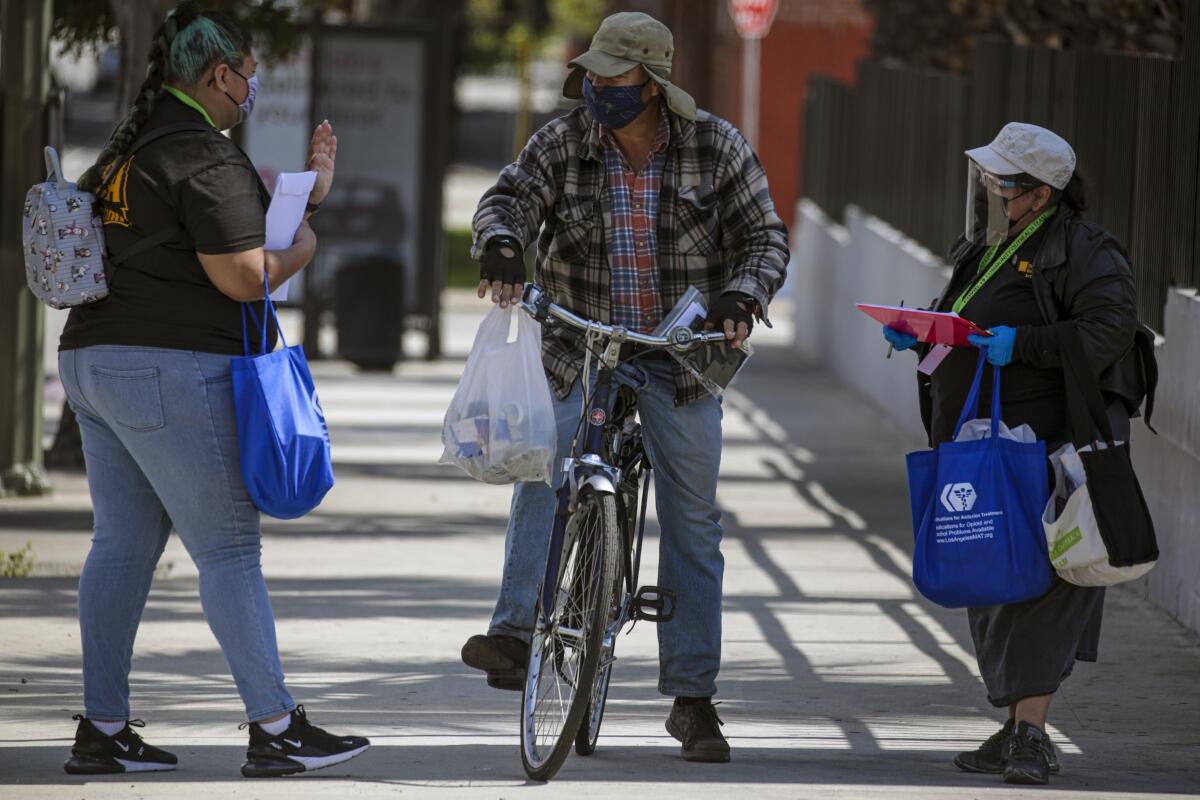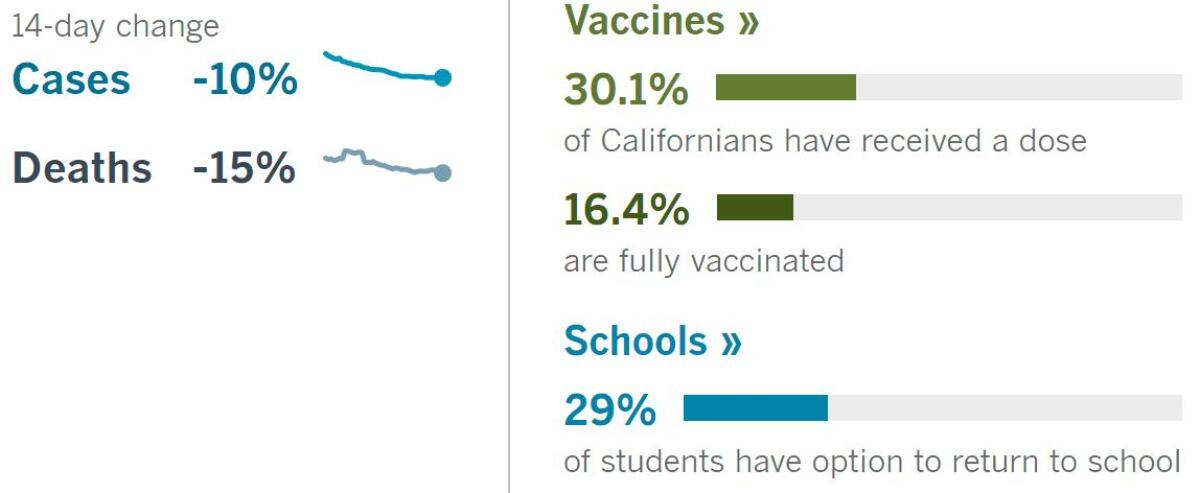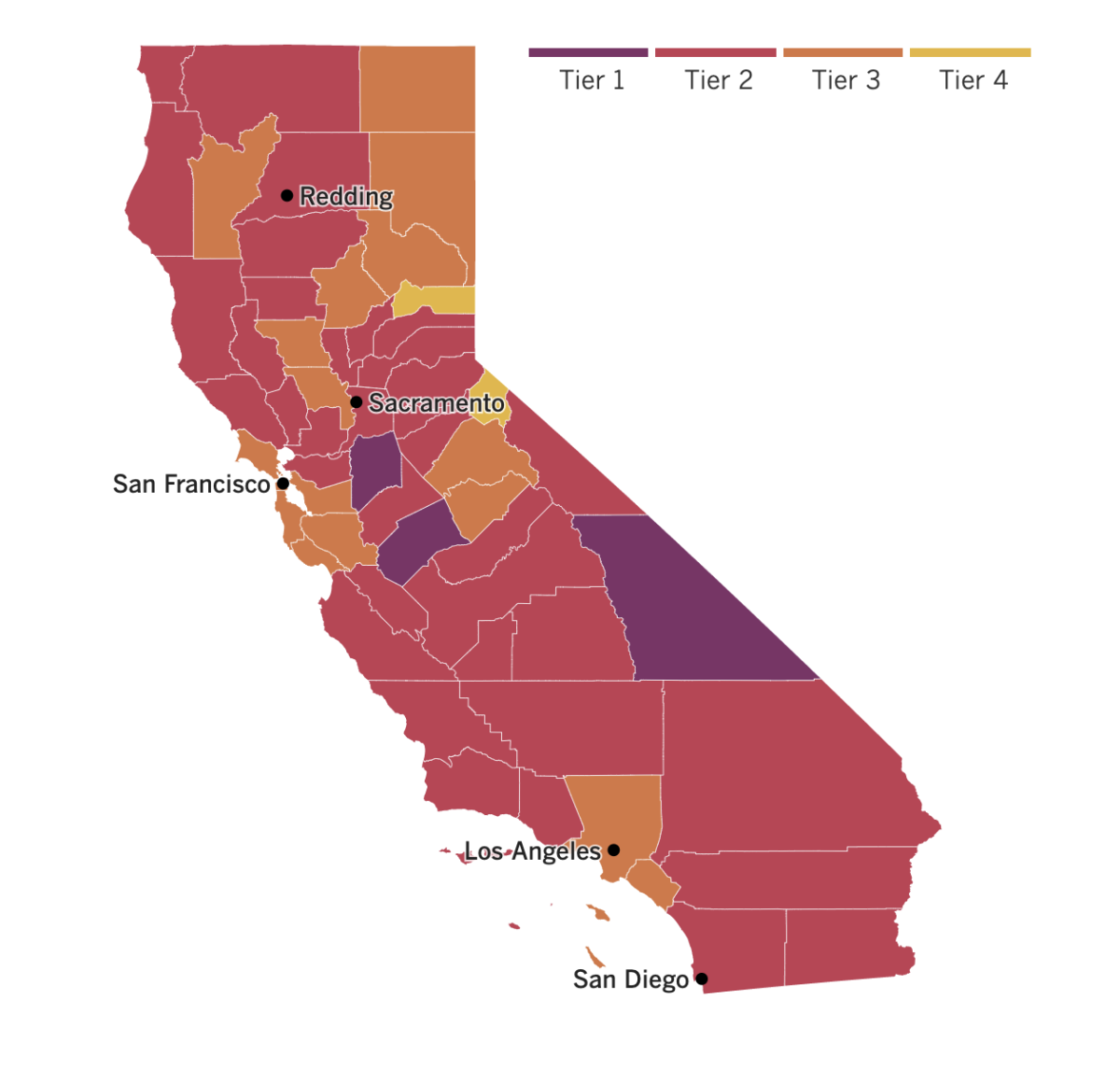Coronavirus Today: The vaccination effort’s boots on the ground
- Share via
Good evening. I’m Amina Khan, and it’s Wednesday, March 31. Here’s what’s happening with the coronavirus in California and beyond.
Things have been looking good in California lately. In about two weeks, the Golden State is opening up the vaccine to everyone age 16 and older. Officials are expecting a serious boost in the vaccine supply. Both these factors should help get more shots into arms than ever before. And in Los Angeles, officials say 4 out of 5 eligible Angelenos could be vaccinated by the end of June.
There is one caveat: Once the doses are available and folks are eligible, you still have to get them signed up.
That’s why my colleague Colleen Shalby introduces us to Maria Mejia, age 53, as she runs through a Food 4 Less parking lot in Boyle Heights chatting people up — a young store employee, a grandfather headed to his car, a woman loading bags into her trunk.
Mejia, armed with a clipboard and a face shield, has a mission: to help people register for COVID-19 shots.
“This is for the sake of the future,” she tells the people she meets.
Mejia and her work partner, 29-year-old Susan Salcido, have spent two months walking the streets around East Los Angeles and Boyle Heights to ensure that residents, shopkeepers, taco vendors and practically anyone else they meet knows everything they need to know about the COVID-19 vaccines.
It’s no secret that Latino communities have endured some of the worst suffering of the pandemic. Latino Californians have the highest rate of employment in essential front-line jobs, where there’s a higher risk of exposure, and in L.A.’s high-priced housing market, many live in crowded homes, where the virus can more easily spread. And they have died of COVID-19 at far higher rates than their white peers.
California has been trying to ensure that enough doses are available to these coronavirus-battered communities. Forty percent of all doses are being allocated to 400 ZIP Codes that have suffered a disproportionate toll from the pandemic, ones in East L.A. and Boyle Heights included.
But it’s not enough to make the doses available to the communities that need them; you have to give people in those communities the information and the help they need to sign up.
Mejia and Salcido, who work for educational nonprofit Soledad Enrichment Action, are part of the small army of outreach workers whose goal is to tackle misperceptions about the virus and the vaccine in predominantly Latino communities. Mejia reaches out in Spanish, Salcido in English and, occasionally, sign language. Together they check people’s eligibility, share coronavirus facts, dispel myths, and take names to register people for shots.

“We’ve talked to hundreds of people,” Salcido said, as she left the parking lot for another store across the street. “I think in a day, face to face, especially in an area like this, we could get more than 200.”
One recent rainy day, the pair worked to cover a 20-block area, speaking to folks running a burrito truck, a man on a bicycle, and a homeless man outside the post office. They traveled on foot for hours, carrying bags filled with masks and fliers.
And they often opened up to those they met by sharing their own experiences: Both had COVID-19 last year, and both have since been vaccinated.
It’s a great story that highlights a fundamental truth: Beating a pandemic doesn’t just happen with changes to logistics and policy. It happens in part thanks to people like Salcido and Mejia, who walk the walk, reach out and share their own stories. Bearing useful information and a human touch, these workers help to bring residents over the vaccination effort’s finish line.
By the numbers
California cases, deaths and vaccinations as of 6:13 p.m. Wednesday:

Track California’s coronavirus spread and vaccination efforts — including the latest numbers and how they break down — with our graphics.

Across California
California has yet to see the rising coronavirus numbers experienced in other parts of the country — but that hasn’t stopped some officials from worrying as parts of the Southland were cleared for significant reopenings as soon as this week.
Los Angeles and Orange counties, two of California’s most populous, were moved into the orange tier, the second-to-least-restrictive level of the state’s four-color reopening framework. Still, even though this would allow a significant loosening of restrictions on businesses and activities, some officials are stressing caution.
Whereas Orange County’s reopenings go into effect today, L.A. County Public Health Director Barbara Ferrer said the county would wait until 12:01 a.m. on Monday to implement the changes. That way, officials will have more time first to make sure the last local round of reopenings, which began March 15, has not boosted coronavirus transmission.
“There is a good reason for us to remain in a tier for three weeks before accelerating into a less restrictive tier, because we need this third week to make sure that we’re not seeing an increase in cases,” she said during a briefing. “Remember, this still is a virus that has a very long incubation period, so this week becomes critical.”
While COVID-19 vaccine skepticism has dropped in the Golden State as more folks get their shots, resistance still remains stubbornly high among Republicans, a new poll shows — a potential roadblock on the path to achieving herd immunity.
According to the poll results from the Public Policy Institute of California, 26% of registered Republicans said they definitely will not get vaccinated, and 13% said they probably won’t. That 39% hesitancy rate is the highest of any group surveyed.
About 29% of Black Californians said they would probably or definitely refuse the vaccine, down from 55% in January. Among Latinos, 22% are hesitant; that rate has not changed in the last two months.
The rate of Republicans who said they would not get vaccinated has declined only slightly since January, dropping 4 percentage points from 43%, the pollsters found.
The results echo similar findings in other recent U.S. polls out this week. One by the Kaiser Family Foundation found that Republicans (29%) and white evangelical Christians (28%) had the highest rates of vaccine refusal, and a Gallup survey found that Republican respondents were least likely to be vaccinated or plan to be (54%).
Some news on the schools front: A new report by a local advocacy group says that students at all levels have suffered academically since Los Angeles Unified School District closed its campuses over a year ago — and that younger students and those who were faring worse before the pandemic have suffered the worst effects.
The report, titled “Educational Recovery Now” and released Wednesday by Great Public Schools Now, focused on academic efforts and measures during the pandemic. Among its findings:
- More than 13,000 middle and high school students consistently disengaged in fall 2020. An additional 56,000 did not actively participate on a daily basis.
- Two in three students are falling behind in literacy and math.
- Black and Latino students have been disproportionately affected, with only 43% of Black students and 44% of Latino students on track in early reading skills.
The goal of the report is “to start a public conversation on the impacts of a year without in-person instruction on our students, particularly those with the highest needs, and to call on LAUSD to develop a comprehensive educational recovery plan,” its authors said. The L.A. Unified administration declined to respond to the report.


See the latest on California’s coronavirus closures and reopenings, and the metrics that inform them, with our tracker.
Consider subscribing to the Los Angeles Times
Your support helps us deliver the news that matters most. Become a subscriber.
Around the nation and the world
More good news on the vaccine front: Pfizer said Wednesday that its COVID-19 shots were safe and strongly protective in children as young as 12. The results mark a significant step toward potentially rolling out the vaccine to young teens before many head back to classrooms this fall.
Most COVID-19 vaccines being rolled out worldwide are for adults; the one from Pfizer and BioNTech is authorized for people 16 and older. But inoculating kids of all ages will be critical to reaching herd immunity, stopping the pandemic in its tracks and letting upper-grade schools return to some semblance of normalcy.
In a study of 2,260 U.S. volunteers ages 12 to 15, preliminary data showed there were no cases of COVID-19 among fully vaccinated adolescents, Pfizer reported. In contrast, there were 18 cases among those given dummy shots. The researchers also found high levels of virus-fighting antibodies in the vaccinated children’s systems, somewhat higher than were seen in studies of young adults.
Dr. Philip J. Landrigan, a pediatrician and epidemiologist at Boston College, called the results encouraging. “It’s hard to get kids to comply with masking and distancing, so something that gives them hard protection and takes them out of the mix of spreading the virus is all for the good,” said Landrigan, who was not involved in the study.
In Mexico, the vaccine rollout has been painfully slow, and just 4% of the population of 128 million has received a dose. The faltering inoculation campaign has sent wealthy Mexicans flocking to the U.S. to get their shots, my colleagues Kate Linthicum and Molly Hennessy-Fiske report.
Mauricio Fernández Garza, a 70-year-old businessman and former mayor of a city that is Latin America’s wealthiest, chartered a private jet to fly to Brownsville, Texas, then drove to Los Fresnos, a farming community about 20 minutes away. He waited in a short line at a vaccination site, provided his Mexican passport as proof of identification and received his first dose of the Moderna vaccine. He made the same trip the next month for his second dose.
“Mexico is lagging behind,” said Fernández. “A lot of people have access to the United States, and they are going to protect themselves.”
The phenomenon underscores both Mexico’s deep inequalities and its struggle to protect its residents against the coronavirus. Last week, the government publicly confirmed that more than 320,000 Mexicans have died due to the pandemic — far more than previously reported. And trips like Fernández’s are expected to increase in the coming months as states across the U.S., including California, open their vaccine programs to all adults.
On to Madrid, where young, multilingual groups of fun-seekers from Italy, the Netherlands, Germany and France are joining local peers to party in ways they haven’t for months because of strict pandemic lockdowns at home.
“It’s a real privilege for me to go into bars because in France you can’t. Here I can go to restaurants, share time with friends outside of home, discover the city,” said Romy Karel, 20, who flew to the Spanish capital from Bordeaux.
Many visitors head for underground gatherings advertised via messaging groups when curfew begins, while others recruit fellow revelers on their way back to rented Airbnbs. Last weekend, police said they broke up more than 350 illegal parties.
Spain recently said it would extend a negative coronavirus test requirement in effect for arrivals by sea or air to include those entering from France by land. But foreigners can still fly direct from Munich or Bordeaux to beach resorts or cultural wonders in Spain, while Spaniards can’t travel across regions in the country to their second homes or visit relatives.
This irks some residents, such as Nuria López, a 45-year-old pastry shop owner in the Spanish capital. “It’s unfair,” López said. “But it does help the economy in Madrid, and we need that.”
Partygoers aren’t the only ones letting their hair down in Spain. Last weekend in Barcelona, Gustavo Dudamel, the Los Angeles Philharmonic conductor, pulled off an in-person, indoor production of Verdi’s Otello in Barcelona for an audience of about 1,000 as he huddled with 50 musicians in the orchestra pit and 75 singers packed the stage.
It’s in sharp contrast to other cultural centers in Europe, where concert halls in Vienna and theaters in London remain shuttered — but perhaps not surprising in a country where officials have called culture “a basic human right.”
Your questions answered
Today’s question comes from readers who want to know: I’m at least 50 years old and qualify for a vaccine starting April 1. What do I need to know?
Obviously, it’s an issue top of mind for the Californians who will be able to get in line for a vaccine tomorrow. My colleague Colleen Shalby has laid out the basics for people in this category.
Who qualifies: In California, starting Thursday, if you’re older than 50, you can get vaccinated. Two weeks later, on April 15, anyone age 16 and up will be eligible.
Roughly half the state’s residents currently qualify by belonging to a range of categories: healthcare workers, adults 65 and older, individuals with high-risk disabilities and underlying health conditions, educators and child-care workers, food service workers, those who work in incarceration facilities or homeless shelters, public transit workers, emergency service workers and vaccine clinic volunteers, among others. And some local health jurisdictions have expanded eligibility beyond that state guidance.
How to get an appointment: The not-great news first: Newly eligible residents may have to wait a bit longer before they can lock down an appointment. The state’s My Turn scheduling site is allowing residents in L.A. County and elsewhere who become eligible Thursday to start making appointments on Wednesday, though time slots have been scarce.
State or local hotlines may help. The state’s COVID-19 hotline — at (833) 422-4255 — is open from 8 a.m. to 8 p.m. Monday through Friday and from 8 a.m. to 5 p.m. Saturday and Sunday. In Los Angeles County, those with disabilities or without computer access are encouraged to call (833) 540-0473 between 8 a.m. and 8:30 p.m. daily.
The current supply outlook: The state’s vaccine allocation has grown to about 1.8 million doses per week. As more supply of the Johnson & Johnson vaccine comes in, that number will almost certainly jump up.
President Biden said Monday that a record 33 million doses would be distributed across the country this week. In L.A. County, officials said Friday they expect to receive about 338,100 doses — the highest weekly allotment to date.
Still, that won’t be enough to accommodate all newly eligible people immediately — so for now, if you can’t seem to secure an appointment, patience remains key.
We want to hear from you. Email us your coronavirus questions, and we’ll do our best to answer them. Wondering if your question’s already been answered? Check out our archive here.
Resources
Need a vaccine? Keep in mind that supplies are limited, and getting one can be a challenge. Sign up for email updates, check your eligibility and, if you’re eligible, make an appointment where you live: City of Los Angeles | Los Angeles County | Kern County | Orange County | Riverside County | San Bernardino County | San Diego County | San Luis Obispo County | Santa Barbara County | Ventura County
Need more vaccine help? Talk to your healthcare provider. Call the state’s COVID-19 hotline at (833) 422-4255. And consult our county-by-county guides to getting vaccinated.
Practice social distancing using these tips, and wear a mask or two.
Watch for symptoms such as fever, cough, shortness of breath, chills, shaking with chills, muscle pain, headache, sore throat and loss of taste or smell. Here’s what to look for and when.
Need to get tested? Here’s where you can in L.A. County and around California.
Americans are hurting in many ways. We have advice for helping kids cope, resources for people experiencing domestic abuse and a newsletter to help you make ends meet.
We’ve answered hundreds of readers’ questions. Explore them in our archive here.
For our most up-to-date coverage, visit our homepage and our Health section, get our breaking news alerts, and follow us on Twitter and Instagram.




